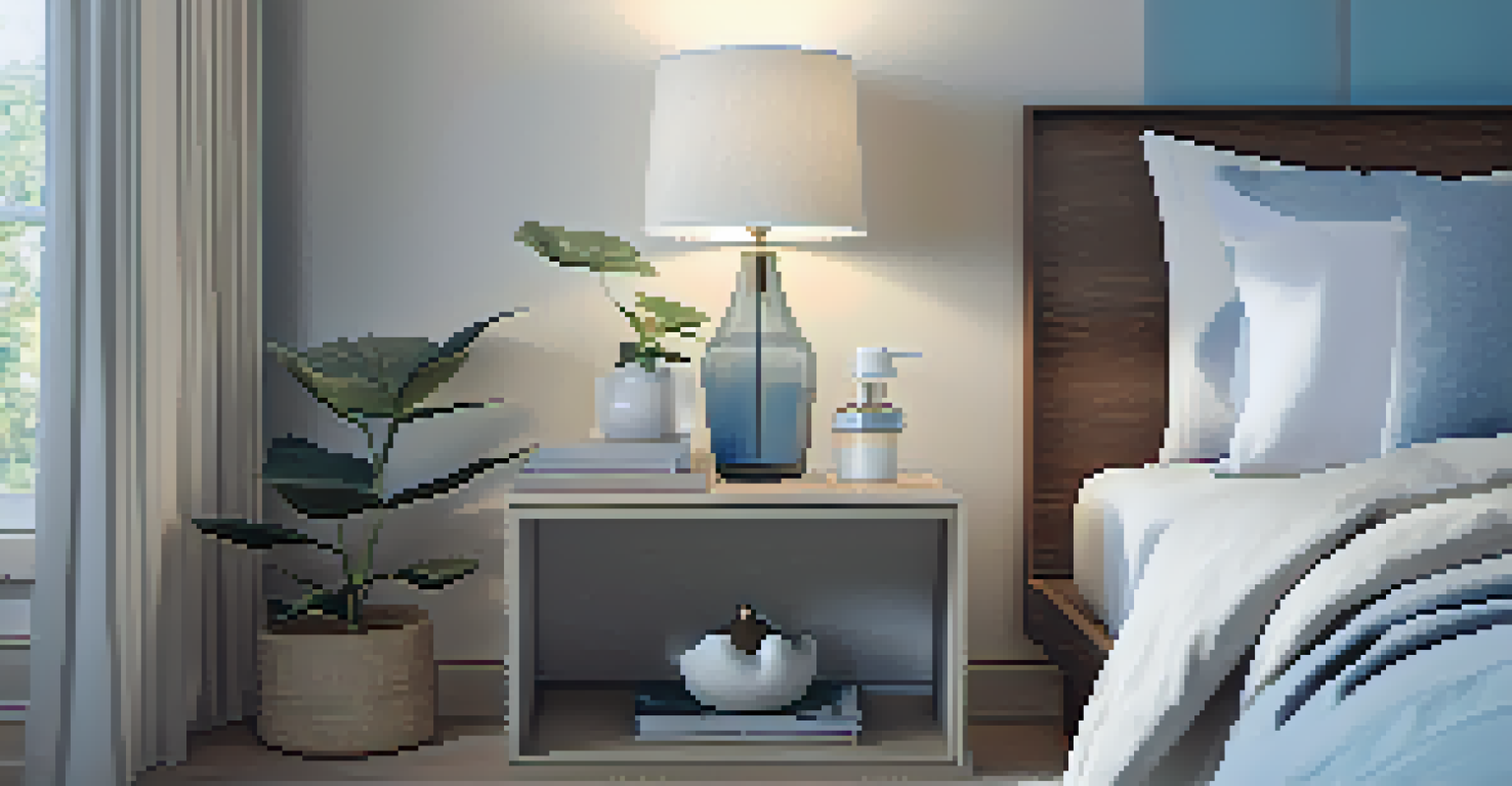How to Create a Healthy Sleep Environment at Home

Understanding the Importance of Sleep Hygiene
Sleep hygiene refers to the practices that promote consistent, quality sleep. Just like we maintain good personal hygiene, it’s essential to cultivate a healthy sleep routine. Without proper sleep hygiene, you might find yourself tossing and turning instead of enjoying restful slumber.
Sleep is the best meditation.
To start, it’s important to recognize the role of your environment in sleep quality. Factors such as noise, light, and temperature can significantly impact how well you sleep. By creating a space that minimizes disruptions, you set the stage for a more restful night.
Incorporating good sleep hygiene not only helps you fall asleep faster but also improves your overall health. It can boost your mood, enhance your cognitive abilities, and even strengthen your immune system. So, let’s explore how to create an ideal sleep environment!
Choosing the Right Mattress and Pillows
Your mattress and pillows are the foundation of your sleep experience. A comfortable mattress supports your body and helps maintain proper alignment, which is crucial for preventing aches and pains. When selecting a mattress, consider factors like firmness and material to find what works best for you.

Similarly, the right pillow can make a world of difference. It should align with your sleeping position—whether you’re a back, side, or stomach sleeper—to ensure neck support. Investing in quality bedding can transform your sleep from restless to restorative.
Create a Sleep-Friendly Environment
A calm and dark bedroom, free from noise and clutter, is essential for promoting restful sleep.
Don’t forget to consider the lifespan of your mattress and pillows. Over time, they can lose their supportive qualities and harbor allergens. Regularly assess their condition and replace them as needed to maintain a healthy sleep environment.
Controlling Light Levels in Your Bedroom
Light plays a crucial role in regulating our sleep-wake cycle, also known as the circadian rhythm. Excessive light can signal your brain to stay alert, making it difficult to drift off to sleep. To create a sleep-friendly environment, aim for a dark room when it’s time to rest.
A good laugh and a long sleep are the best cures in the doctor’s book.
Consider using blackout curtains or shades to block out external light sources, especially if you live in a brightly lit area. Additionally, you might want to invest in an eye mask for those nights when total darkness is elusive. These simple adjustments can enhance your ability to relax and fall asleep.
Don’t forget about the light emitted by electronic devices. Blue light from screens can disrupt melatonin production, the hormone responsible for sleep. Try to limit screen time at least an hour before bed to help signal your body that it’s time to wind down.
Creating a Comfortable Room Temperature
The temperature of your bedroom can significantly affect your sleep quality. Ideally, most sleep experts recommend keeping your room between 60 to 67 degrees Fahrenheit for optimal comfort. A cooler environment can help lower your body temperature, signaling to your brain that it's time to sleep.
If you find your room too warm, consider using a fan or air conditioning to maintain a comfortable temperature. Alternatively, layering your bedding allows you to adjust your warmth as needed throughout the night. Remember, comfort is key!
Invest in Quality Sleep Gear
Choosing the right mattress and pillows tailored to your sleeping position can significantly enhance your comfort and support.
Additionally, breathable materials for your sheets and pajamas can aid in temperature regulation. Natural fibers like cotton or linen allow for better airflow, ensuring you don’t wake up feeling overheated. Make these small changes for a more restful night!
Minimizing Noise for a Peaceful Sleep
Noise can be a major sleep disruptor, whether it's traffic sounds, noisy neighbors, or even your partner's snoring. To combat this, consider soundproofing your bedroom with heavy curtains or rugs, which can absorb sound and create a quieter environment. These additions not only help with noise but also enhance the room's aesthetic appeal.
Another effective solution is to use white noise machines or apps that produce soothing sounds to mask disruptive noises. Whether it’s gentle rain or ocean waves, these sounds can help lull you into a deeper sleep. Some people also find that a fan provides a soothing background hum.
If you're sensitive to noise, earplugs can also be a helpful tool. They can block out disturbances, making it easier to relax and drift off. Finding the right combination of strategies will lead you to a quieter, more peaceful sleep environment.
Decluttering Your Sleep Space
A cluttered space can create a cluttered mind, making it difficult to unwind after a long day. Take a look around your bedroom—are there items that don’t belong? Clearing away unnecessary clutter can create a sense of calm and order, setting the perfect stage for sleep.
Start by simplifying your nightstand and removing any distractions, like electronics or work materials. Instead, maybe place a book you love or a calming essential oil diffuser. This helps signal your brain that it’s time to relax and prepare for rest.
Establish a Consistent Sleep Routine
Maintaining a regular sleep schedule helps regulate your internal clock, leading to improved sleep quality and overall well-being.
Regular cleaning and organizing not only enhance the room’s appearance but can also improve your overall sense of well-being. Make it a habit to keep your sleep environment tidy, and you’ll likely notice a positive impact on your ability to fall asleep.
Incorporating Relaxation Techniques Before Bed
Establishing a calming pre-sleep routine can greatly enhance your ability to relax and fall asleep. Consider activities like reading a book, practicing gentle yoga, or enjoying a warm cup of herbal tea. These rituals signal to your body that it’s time to wind down and prepare for sleep.
Mindfulness practices, such as meditation or deep-breathing exercises, can also help clear your mind of the day’s stresses. Taking even a few minutes to focus on your breath can create a sense of tranquility, making it easier to transition into sleep mode.

By incorporating these relaxation techniques into your nightly routine, you foster a deeper connection between your mind and body. This connection is essential for achieving restful sleep and should be considered a vital part of your overall sleep environment.
Establishing a Consistent Sleep Schedule
Consistency is key when it comes to achieving quality sleep. Going to bed and waking up at the same time every day helps regulate your internal clock. This predictability can make it easier to fall asleep and wake up feeling refreshed.
Even on weekends, try to stick to your sleep schedule as closely as possible. While it can be tempting to sleep in, significant changes in your sleep pattern can disrupt your body’s rhythm. Remember, a well-rested mind and body are more productive and healthier.
Creating a consistent sleep schedule also allows your body to enter deeper sleep cycles, which are essential for restorative sleep. Prioritize this habit, and you’ll likely see improvements in your overall sleep quality.